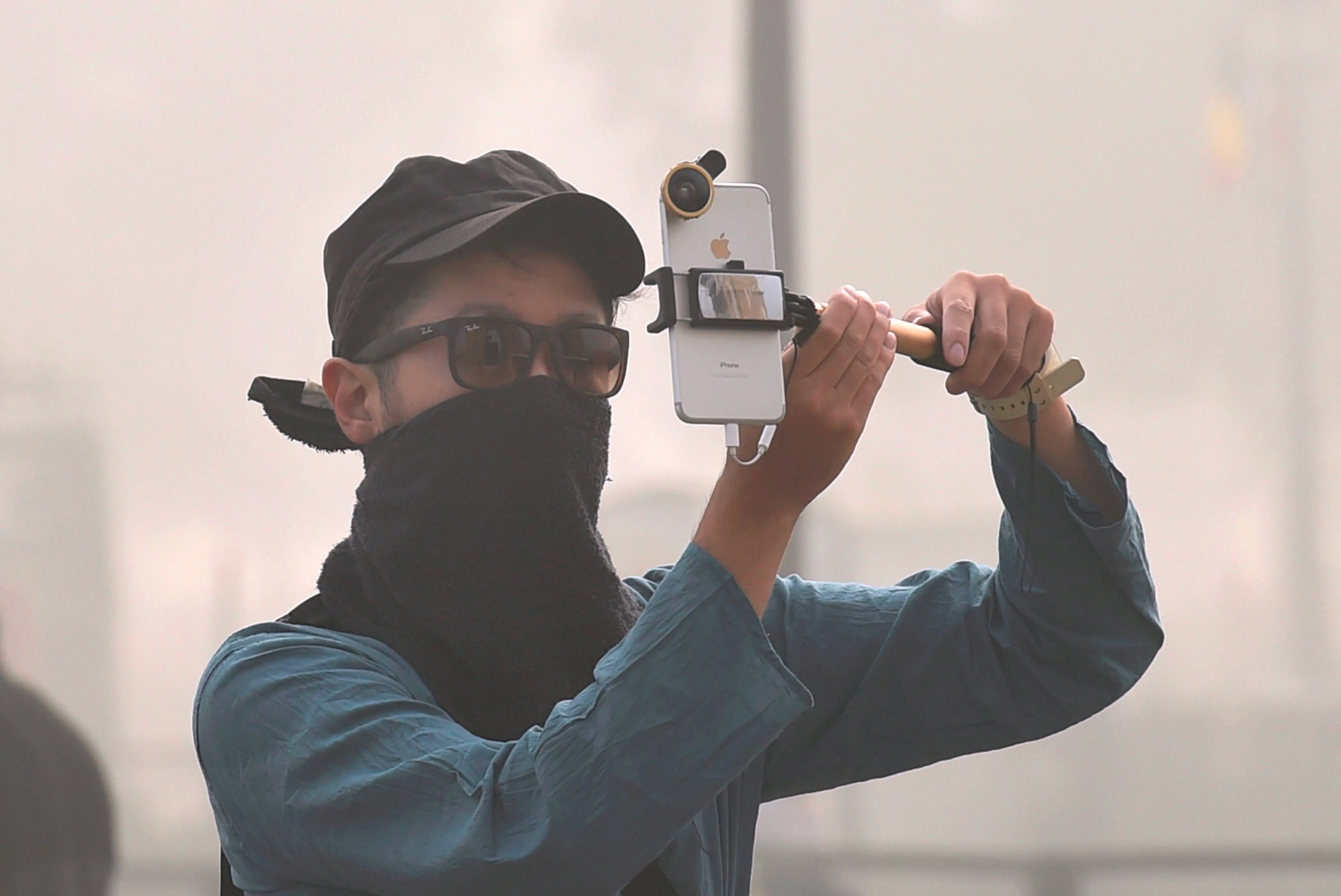
Pollution issues in India will not go away in a hurry. This is because we have still not started measuring and quantifying pollution. Be it the dirty air, it's toxic water or its sewage filled streets, things are likely to go from bad to worse till some crisis grips the nation. Political indifference and administrative and citizens apathy has ensured that little has been done to reverse the trend in the last decade. We have seen governments change both at the Centre and the States, but little change has taken place in our municipal corporations, water and pollution departments.
Though at the political level the awareness has improved, it is still to translate into serious administrative and municipal reforms. Home toilets are pushed as priority, while garbage on the streets remain undiscussed. Private cars are being targeted, but the promised bus fleets to reduce private vehicles are nowhere in sight. Nobody is targeting solutions, but everyone is finger pointing at each other.
The key to addressing any problem is measuring the problem and then planning an adequate response. India has devised no mechanism to measure the extent of pollution, leave alone address it. The air quality in the national capital and major cities is severe for almost three months of a year. The water tables across the country are falling rapidly and the groundwater is turning toxic. Over 40% of India’s garbage remains uncollected on the streets and some of it spills into its water bodies polluting its rivers, including its longest river the Ganga.
Inadequate air quality measurement points
Let us take the issue of air pollution across India, including its capital the Delhi NCR. It has been over five years that the situation has been close to desperate in the winters. The capital which has over three dozen designated industrial areas within the city and its suburbs had just three real time air pollution monitoring stations till last year. The CPCB (Central Pollution Control Board) has added a dozen more measuring stations in Delhi NCR this year, but unfortunately most of them are in the green belt of Lutyens Delhi where the pollution is the least.
Major industrial areas like Naraina, Mayapuri, Peeragarhi, Okhla and Badarpur have been given a short shrift. Noida, Ghaziabad and Faridabad have just one station each while Gurgaon which is less polluted has four. Even in the vast Ghaziabad industrial belt, the CPCB pollution monitoring station is located at Vasundhara, a middle class residential area that has no polluting industrial units. Similarly, in Noida, the CPCB unit is located at sector 125 a newly developed sparsely populated residential area on the express highway.
Major industrial areas like Naraina, Mayapuri, Peeragarhi, Okhla and Badarpur have been given a short shrift. Noida, Ghaziabad and Faridabad have just one station each while Gurgaon which is less polluted has four.
For the rest of the nation, the situation is even more grim. As per the CPCB website, it has real time measuring facility in 54 of India’s 8000 odd cities and towns. The location of these 54 measuring points in 16 cities is pretty arbitrary as they do not focus on areas generating maximum pollution. For example, Madhya Pradesh has four CPCB stations but only Singrauli and Pitampura are having major industrial units. Also, it is strange that major manufacturing States like Tamil Nadu, Karnataka and Gujarat have only one CPCB air pollution measuring station each in their capitals — Chennai, Bengaluru and Ahmedabad.
Ground water turning toxic
The situation is even worse when we talk about the measurement of pollutants in water. The CPCB has no resources to monitor the quality of water bodies across the nation. As a matter of fact, it does not maintain a database of water quality either of the major rivers or the groundwater in major cities across India. This though it is officially mandated to do so.
The mandarins of the environment ministry and the CPCB conveniently ignore their national responsibility to ensure that all pollution data be made available to the citizens of India. On the CPCB site, you can see the statistics of pollution, only of the Yamuna, particularly during its travel through Delhi, but not of other rivers of India. What it says reveals the sad state of affairs of rivers and water bodies of India.
The CPCB states that during the 46 mile traverse through Delhi, between Wazirabad barrage to Okhla barrage, the Yamuna collects 70% of its total pollutants. Water quality is monitored at 4 points in this stretch, namely upstream of Wazirabad, Nizamuddin, and the upstream and downstream of Okhla barrage. The dissolved oxygen level upstream of Wazirabad is well above the minimum permissible limit of 4.0 mg/l but falls to zero to 2.6 mg/l soon after it meets the Shahdara drain. The Total Coliform (TC) which is within permissible limits before Wazirabad barrage jumps by an unbelievable 1000 times when monitored upstream of Okhla.
In response to a recent question in the Lok Sabha, the government admitted that over 239 million people across 153 districts of 21 States drink water with arsenic levels above the permissible limit. The worst affected States are UP, Bihar, Assam and Bengal. As per the World Health Organisation (WHO), this could cause poisoning and cancer of the skin, bladder, liver or lung. However, there is lack of a regular periodic analysis of the water quality across the country, and with rapidly falling water tables and increasing industrialisation, this could lead to a generation lost due to water pollution.
Over 239 million people across 153 districts of 21 States drink water with arsenic levels above the permissible limit.
Need for real time satellite mapping of solid waste
As per the Census data quoted by CPCB, the MSW generated in 59 cities of India in 1999-2000 was 30,058 tonnes per day. This rose to 39,031 TPD in 2004-2005 and 50,592 TPD in 2010-11. Even today, the updated MSW data in all the 230 municipal towns is not available in any government website. This despite the fact that Swachh Bharat is today a national priority and there is no dearth of funds and manpower for the ‘Clean India Drive.’
Since the solid waste is not adequately measured, it is not properly mitigated. The response to the huge piles of garbage that daily clog our streets and water bodies is simply not there. Even the planning of and understanding of the scale of garbage management is lacking. This is because the numbers are not real or accurate. On top of it, the municipal corporations that are supposed to manage the MSW are often politicised, disorganised, and inadequately funded.
There are thousands of new unauthorised garbage piles that litter our parks, roads, rivers and lakes each month that we do not keep track of. As the major dump yards are choking and overflowing, the municipal bodies, especially in smaller towns, are dumping garbage in open spaces that have no official sanction. So, the once in a decade count of the garbage that ‘India produces daily’ is grossly inadequate.
If roads can be mapped by satellites by Google or any other entity, why cannot garbage dumps be. It is high time that the Government takes the initiative and talks to Google or even ISRO to develop a satellite based real time monitoring app that tells us the location, height and area of the garbage we accumulate daily. Technology solutions exist today but it depends on us how we use it effectively to handle these monumental man-made environmental challenges that we face today.
The views expressed above belong to the author(s). ORF research and analyses now available on Telegram! Click here to access our curated content — blogs, longforms and interviews.



 Pollution issues in India will not go away in a hurry. This is because we have still not started measuring and quantifying pollution. Be it the dirty air, it's toxic water or its sewage filled streets, things are likely to go from bad to worse till some crisis grips the nation. Political indifference and administrative and citizens apathy has ensured that little has been done to reverse the trend in the last decade. We have seen governments change both at the Centre and the States, but little change has taken place in our municipal corporations, water and pollution departments.
Though at the political level the awareness has improved, it is still to translate into serious administrative and municipal reforms. Home toilets are pushed as priority, while garbage on the streets remain undiscussed. Private cars are being targeted, but the promised bus fleets to reduce private vehicles are nowhere in sight. Nobody is targeting solutions, but everyone is finger pointing at each other.
The key to addressing any problem is measuring the problem and then planning an adequate response. India has devised no mechanism to measure the extent of pollution, leave alone address it. The air quality in the national capital and major cities is severe for almost three months of a year. The water tables across the country are falling rapidly and the groundwater is turning toxic. Over 40% of India’s garbage remains uncollected on the streets and some of it spills into its water bodies polluting its rivers, including its longest river the Ganga.
Pollution issues in India will not go away in a hurry. This is because we have still not started measuring and quantifying pollution. Be it the dirty air, it's toxic water or its sewage filled streets, things are likely to go from bad to worse till some crisis grips the nation. Political indifference and administrative and citizens apathy has ensured that little has been done to reverse the trend in the last decade. We have seen governments change both at the Centre and the States, but little change has taken place in our municipal corporations, water and pollution departments.
Though at the political level the awareness has improved, it is still to translate into serious administrative and municipal reforms. Home toilets are pushed as priority, while garbage on the streets remain undiscussed. Private cars are being targeted, but the promised bus fleets to reduce private vehicles are nowhere in sight. Nobody is targeting solutions, but everyone is finger pointing at each other.
The key to addressing any problem is measuring the problem and then planning an adequate response. India has devised no mechanism to measure the extent of pollution, leave alone address it. The air quality in the national capital and major cities is severe for almost three months of a year. The water tables across the country are falling rapidly and the groundwater is turning toxic. Over 40% of India’s garbage remains uncollected on the streets and some of it spills into its water bodies polluting its rivers, including its longest river the Ganga.
 PREV
PREV


